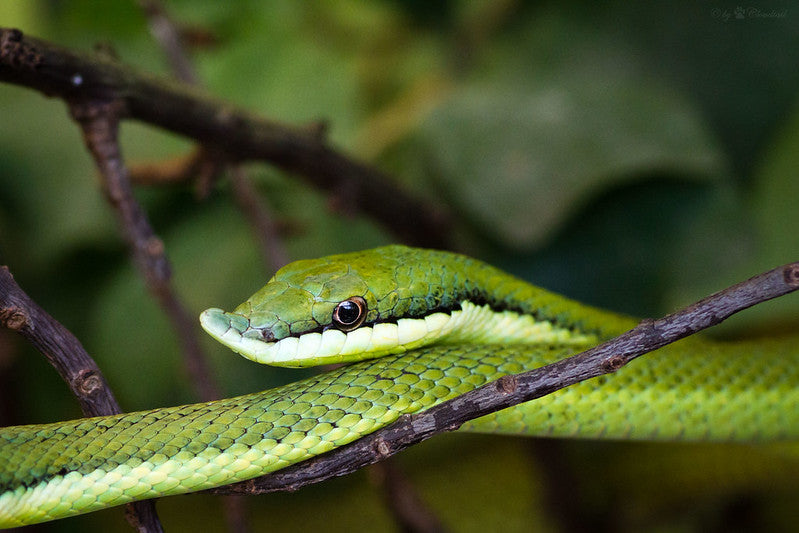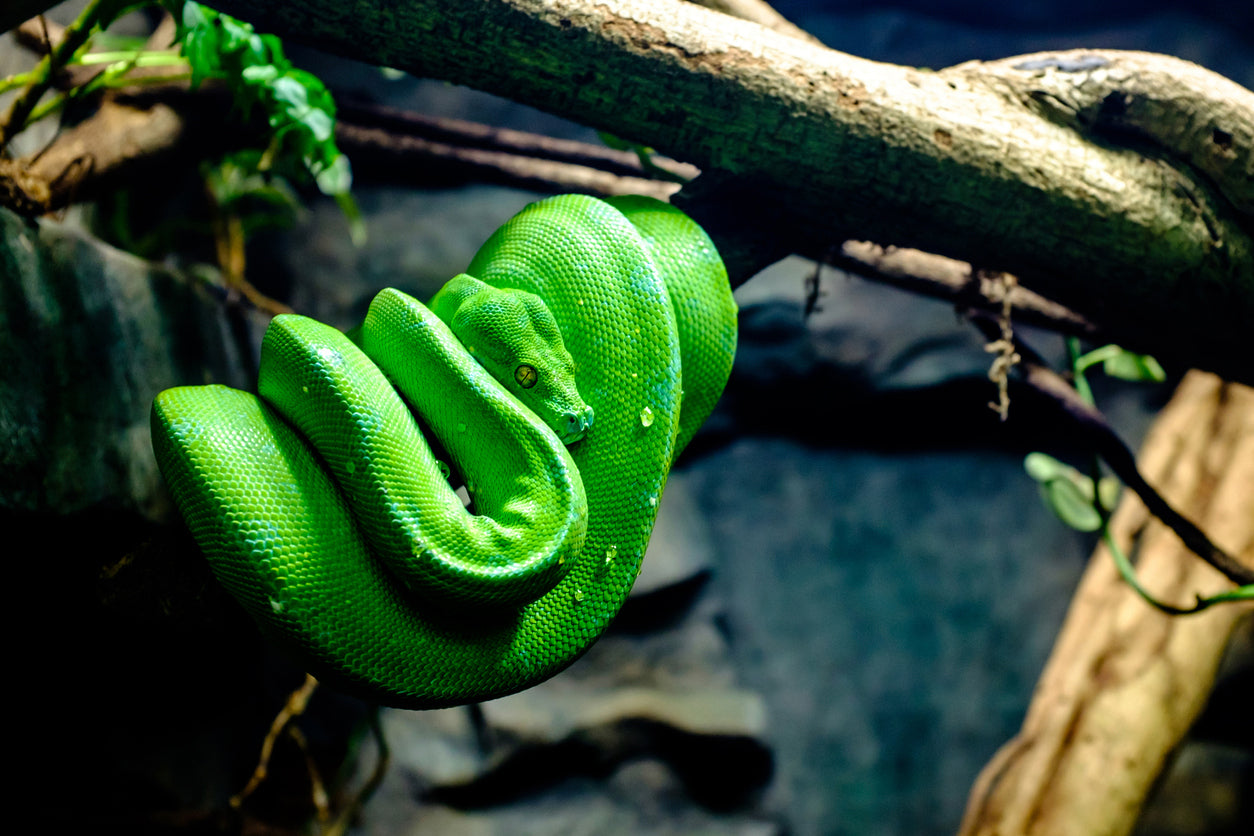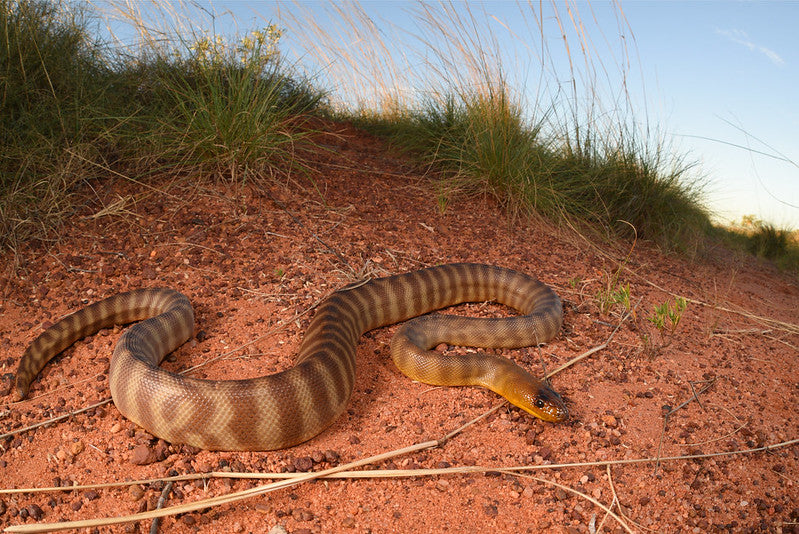Baron’s green racers (Philodryas baroni) are medium-sized, arboreal snakes native to central South America, specifically Argentina, Bolivia, and Paraguay. Their preferred habitat is semi-arid rather than tropical in climate.
Baron’s racers grow 4.5’ to 6’ long, with females being longer and thicker than males. They have a slender body, tapered head, round pupils, and a distinctively upturned snout. This species typically has a leaf green back with a pale underside, the two colors separated by a thin black stripe. However, the amount of black varies per individual, and their dorsal coloring can be brown or blue instead of green.
Baron’s racers are relatively rare in the pet trade, but can make good pets/display animals due to their distinctive appearance and hardiness. Keep in mind, however, that this species is rear-fanged venomous. Although they are not particularly eager to bite humans nor considered particularly dangerous, envenomation is possible.
How much space do Baron’s racers need?
Because Baron’s racers are slender, many people think of them as smaller than they really are, keeping them in enclosures that are too small for them to stretch out fully and explore. The minimum for appropriately keeping one adult Baron’s racer is 5’L x 2.5’W x 2.5’H. This is just the minimum, so using larger dimensions (both taller and wider) is beneficial and will happily be used!
Cohabitation (keeping multiple Baron’s racers in one enclosure) is not recommended, as this is not a social species. While keeping them together generally is not associated with conflicts, it can make feeding time complicated and requires a significantly larger enclosure.
Do Baron’s racers need UVB?
They can survive without it, but it’s still best practice to provide UVB lighting for optimal health and wellbeing, especially since Baron’s racers are a diurnal species. UVB gives Baron’s racers all of the vitamin D that their bodies need, stimulates better appetite and activity, and generally allows them to be healthier than they would be without.
The best UVB bulbs for a Baron’s racer housed in a 5’ x 2.5’ x 2.5’ enclosure are:
- Zoo Med Reptisun T5 HO 10.0, 34”
- Arcadia Forest 12%, 34”
If the UVB bulb is housed inside a Zoo Med T5 HO Terrarium Hood reflective fixture and placed close to the heat lamp, about 6-8” above the basking branch if the lamp is over mesh, and 8-10” if the lamp is inside the enclosure. UVB is blocked by glass and plastic, so you can’t give your snake UVB by placing its terrarium in front of an open window. Also make sure that the fixture your UVB bulb is in does not have a clear plastic bulb cover.
Lights should be on for 13 hours/day during summer and 11 hours/day during winter. This helps encourage more natural hormonal rhythms and better health.
What basking temperatures do Baron’s racers need?
Like other reptiles, Baron’s racers are ectotherms, which means that they need a temperature gradient in their enclosure to help them regulate their metabolism and stay healthy.
Baron’s racers should have a basking temperature of 90°F. Ambient (air) temperature should be kept between 75-85°F. Heat lamps should be turned off at night and temperatures allowed to drop as low as 68°F. Temperatures should be measured with a couple of digital probe thermometers, with one probe placed on the basking branch and the other on the cool side of the setup.
Provide heat for your snake by imitating the sun with a cluster of at least two incandescent heat lamps placed on one side of the enclosure, positioned over a sturdy basking branch. Do not use ceramic heat emitters (CHEs), red bulbs, or blue bulbs, as these are not as effective.
If temperatures are too high, dial the lamp down with a lamp dimmer or rheostat. If temperatures are too low, you will need higher-wattage bulbs.
What humidity levels do Baron’s racers need?
Baron’s racers evolved in a fairly dry environment, so they don’t need much in the way of humidity. A perpetually moist environment is likely to give your snake skin problems, so average humidity should be kept under 50%, although occasional spikes higher are safe. Use a digital probe hygrometer with the probe placed in the middle of the enclosure. Humidity will naturally fluctuate between lower during the day and higher at night.
Baron’s racers generally prefer to drink their water off leaves rather than from a bowl. Lightly misting your snake’s enclosure with a sprayer 3-6x/week (depending on ventilation) gives your snake the opportunity to drink the way it prefers without spiking humidity to dangerous levels.
What substrate is good for Baron’s racers?
Baron’s racers may be arboreal, but they do occasionally spend time on the ground, so it’s beneficial to provide a thin layer of appropriate substrate to cushion their bodies during terrestrial time. As an added perk, it also tends to make the enclosure more attractive.
Ideally, this substrate should resemble what Baron’s racers naturally live on in the wild, which according to in situ observations is often sand or fine sandy soil. It should have small particles and not be too dusty. We recommend the following substrates for Baron’s racers:
- Zoo Med Excavator Clay
- Zoo Med ReptiSand
- Exo Terra Desert Sand
- Exo Terra Riverbed Sand
Substrate should be 1-2” deep and completely replaced every 3-4 months. Remove poop and urates daily, along with contaminated substrate.
What décor can you use in a Baron’s racer terrarium?
It’s terribly boring (and more importantly, stressful) for a snake to be stuck in an enclosure with nothing in it. It doesn’t matter how big the enclosure is if you don’t put things in it for your pet to use and interact with. This is especially the case for arboreal species for which climbing is a routine part of their behavioral repertoire.
Aside from hiding places, you will also need at least a couple of sturdy branches for your snake to climb on, as well as some live or artificial foliage to provide cover. Additional options include:
- more branches
- cork tubes
- ledges
- live or artificial plants
- leaf litter
Note that larger plants are usually sturdier, which is one argument for using a taller enclosure than the minimum.
What do Baron’s racers eat?
Like other snakes, Baron’s racers are carnivores, which means that they need to eat whole animal prey in order to get the nutrition that they need. Here is a basic feeding schedule based on snake size:
- Hatchlings should be fed once every 5 days.
- Juveniles should be fed once every 7 days.
- Adults should be fed once every 7-10 days.
Prey items should be around 10% of your snake’s weight or no more than 1.5x its width. Although live prey can be used, it’s safest and most humane to use frozen instead. Prey should be thawed in a plastic bag in warm water to approximately 100°F before offering with a pair of soft-tipped tweezers.
Remember, the key to great nutrition is variety! Aside from offering mice and rats, quail, chicks, and frog meat can also be used to create nutritional variety in your pet’s diet.
Supplements
Baron’s racers can survive without vitamin or mineral supplements, but occasionally using them can help prevent nutritional deficiencies and optimize your snake’s health. We recommend Repashy Calcium Plus LoD.
Water
Your Baron’s racer should have access to clean, fresh water at all times. Keep a small water bowl readily accessible. Change the water daily and scrub the bowl with a reptile-safe disinfectant weekly, or whenever it becomes soiled.
Do Baron’s racers like to be handled?
Few reptiles actually “like” to be held, and Baron’s racers are generally better display animals than a pet that you can handle regularly. If you need to handle your snake, it’s best to let it come to you rather than to grab it. Be gentle, and pick up the snake from below rather than from above. Support as much of its body as possible, and NEVER pick up a snake by its tail!
Baron’s racers may be rear-fanged venomous, but they’re not particularly predisposed to biting humans unless they confuse you for prey. In the rare event of a bite, the venom is unlikely to do more than cause uncomfortable localized swelling. However, if symptoms don’t improve after 48 hours of the bite, see a doctor.
*This care sheet contains only very basic information. Although it’s a good introduction, please do further research with high-quality sources to obtain additional information on caring for this species.
"argentinian long nosed tree snake" by Cloudtail the Snow Leopard is licensed under CC BY-NC-ND 2.0.




Leave a comment
This site is protected by hCaptcha and the hCaptcha Privacy Policy and Terms of Service apply.